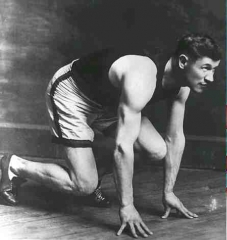On the 100th anniversary of the Olympic Games in which athletes Jim Thorpe (Sac and Fox), Duke Kahanamoku (Native Hawaiian), Andrew Sockalexis (Penobscot) and Lewis Tewanima (Hopi) represented the United States in Stockholm, the Smithsonian’s National Museum of the American Indian presents “Best in the World: Native Athletes in the Olympics.”
The exhibition opened on Friday, May 25; honoured Athletes Include Jim Thorpe, Billy Mills and Duke Kahanamoku. Story and images courtesy of the Smithsonian’s National Museum of the American Indian.
In 1912, Thorpe swept both the pentathlon and decathlon at the Olympic Games, becoming the first and only Olympian to accomplish such a feat and earning the accolades of King Gustav V of Sweden, who proclaimed Thorpe to be “the greatest athlete in the world.” Thorpe was joined that year by fellow Native teammates Kahanamoku, who won the 100-meter freestyle; Sockalexis, who placed fourth in the marathon; and Tewanima, who won the silver medal and set an American record for the 10,000 meters that stood for more than 50 years until Billy Mills (Oglala Lakota) won the gold medal in Tokyo in 1964.
A century later, the National Museum of the American Indian celebrates the legacy of the 1912 team and the path they paved for future generations of Native American athletes, including Clarence “Taffy” Abel (Ojibwe), who won a silver medal as part of the 1924 U.S. Olympic ice hockey team and later became the first U.S.-born player in the National Hockey League; Ellison Myers Brown (Narragansett), who ran the marathon at the 1936 Olympics; Sharon and Shirley Firth (Gwich’in), twin sisters who competed in the 1972, 1976, 1980 and 1984 Games in cross-country skiing; Theoren Fleury (Métis/Cree), who won a gold medal in 2002 in ice hockey, and Carolyn Darbyshire-McRorie (Métis), who won a silver medal in curling in 2010, among others.
Olympic Medals and Objects
The exhibition will be on view until Sept. 3rd in the museum’s Sealaska Gallery. It will feature the gold medals restored to Thorpe’s family in 1983 for his victory in the 1912 decathlon and pentathlon events. Thorpe’s medals were on view at the museum until July 9, at which point they travelled to the London 2012 Summer Olympics Games, where they shall be celebrated and displayed in front of millions of spectators.
On the 100th anniversary of the Olympic Games in which athletes Jim Thorpe (Sac and Fox), Duke Kahanamoku (Native Hawaiian), Andrew Sockalexis (Penobscot) and Lewis Tewanima (Hopi) represented the United States in Stockholm, the Smithsonian’s National Museum of the American Indian presents “Best in the World: Native Athletes in the Olympics.” The exhibition opened on Friday, May 25; honoured Athletes Include Jim Thorpe, Billy Mills and Duke Kahanamoku. Story and images courtesy of the Smithsonian’s National Museum of the American Indian.
In 1912, Thorpe swept both the pentathlon and decathlon at the Olympic Games, becoming the first and only Olympian to accomplish such a feat and earning the accolades of King Gustav V of Sweden, who proclaimed Thorpe to be “the greatest athlete in the world.” Thorpe was joined that year by fellow Native teammates Kahanamoku, who won the 100-meter freestyle; Sockalexis, who placed fourth in the marathon; and Tewanima, who won the silver medal and set an American record for the 10,000 meters that stood for more than 50 years until Billy Mills (Oglala Lakota) won the gold medal in Tokyo in 1964.
A century later, the National Museum of the American Indian celebrates the legacy of the 1912 team and the path they paved for future generations of Native American athletes, including Clarence “Taffy” Abel (Ojibwe), who won a silver medal as part of the 1924 U.S. Olympic ice hockey team and later became the first U.S.-born player in the National Hockey League; Ellison Myers Brown (Narragansett), who ran the marathon at the 1936 Olympics; Sharon and Shirley Firth (Gwich’in), twin sisters who competed in the 1972, 1976, 1980 and 1984 Games in cross-country skiing; Theoren Fleury (Métis/Cree), who won a gold medal in 2002 in ice hockey, and Carolyn Darbyshire-McRorie (Métis), who won a silver medal in curling in 2010, among others.
Olympic Medals and Objects
The exhibition will be on view until Sept. 3rd in the museum’s Sealaska Gallery. It will feature the gold medals restored to Thorpe’s family in 1983 for his victory in the 1912 decathlon and pentathlon events. Thorpe’s medals were on view at the museum until July 9, at which point they travelled to the London 2012 Summer Olympics Games, where they shall be celebrated and displayed in front of millions of spectators.
